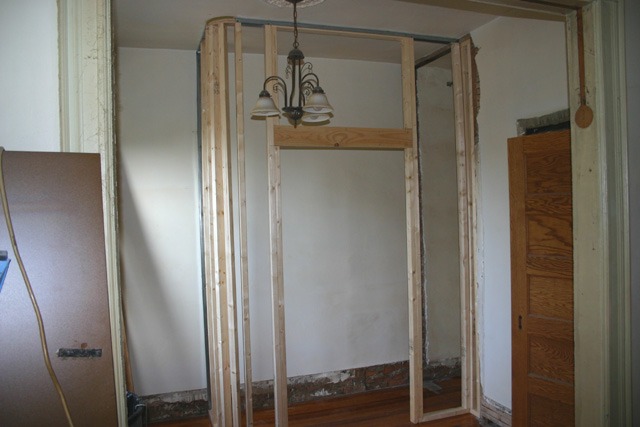I’ve been fighting a sore throat and sniffles all day, but I’m tired of my belly aching. That’s why I’m so behind bloody schedule here.
Yesterday, I got the rough framing done for the new closet in the master bedroom. Well, almost done. I thought I had the 4″ lags and shields I needed for the upper cabinet’s deck support. Because these houses don’t have attics, I need to build one for dead storage. There will be two levels in this closet, with cabinet doors on top.
I want a profiled corner on the closet, not a square edge. This will make a softer return back to some oak built-ins I have planned for the space on the left (four 42″ drawers and a linen cabinet above).
 The curved corner top and bottom plates were made from 3/4″ scrap plywood. I made a circle from a tracing of my drill press table, then scribed the inner diameter with a compass.
The curved corner top and bottom plates were made from 3/4″ scrap plywood. I made a circle from a tracing of my drill press table, then scribed the inner diameter with a compass.
You might notice something odd about the top plates. I like using metal track in lumber framing, at least in situations like this where I have to frame a wall in place. It’s unconventional but I have my reasons.
One: despite well-meaning friends, I invariably wind up doing these jobs by myself and metal track is a lot easier to handle on a ladder than 2-by lumber. Another reason is because the metal channel applies friction against the side of the stud to hold it in place. This lets me do my stud spacing comfortably on the floor. Then I nail/screw in the bottom of all the studs. I set the plumb while standing on a ladder. The metal track makes that easier as well because it holds the stud lightly in place as I tap it into plumb. A couple of fine-threaded screws through the track attaches the stud at the top. Done.
Metal track also means that you don’t have to be as precise with cutting stud lengths. If a stud is 1/8″ short, the track will still grab it. If the wall and floor are splayed a bit, no problem. You won’t have to toss a stud or wedge it with a shim because you cut it a hair too short. But what it mainly means is saving time. You can cut all your studs at once, slip them into the track, do your alignment, plumb and fasten.
Even though I’ve got a nice Hitachi framing nailer, I like to toenail studs with coated deck screws. Screws give me the option of fixing measuring mistakes or changing my mind. Things that look great on paper don’t always make it when you see them in context, like the position of a wall opening. Also, the Hitachi has so much torque that if the nail hits a knot it can kick the stud out of plumb by an inch or more. I have two Dewalt cordless drills; one loaded with a bit to predrill the pocket hole and one with a screwdriver bit.
I’m also a fan of construction adhesive, particularly when working on old houses like this one. You never know if the nail/screw you just drove into the wall planted itself in a cracked or dry rotted 100 year-old joist. It’s a little bit of cheap insurance is all.
My next task is to retrieve the leftover drywall and A/D plywood my neighbor is giving me from his five month repairs following a basement fire. Actually, my next task is to hit the sack with a warm beverage and a bottle of C and beat this bug. It’s strange. Every time I rip down plaster here I seem to come down with a cold or flu a couple of days later. Sometimes I wonder what ancient, sleeping diseases are lurking behind these old walls.
![]()

